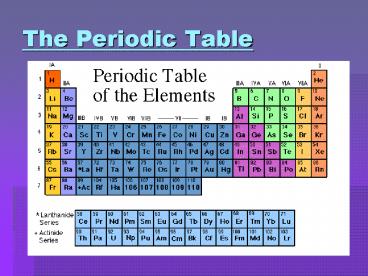The Periodic Table - PowerPoint PPT Presentation
1 / 13
Title:
The Periodic Table
Description:
The Periodic Table Mendeleev s Periodic Table In the 1860 s Mendeleev was working on a textbook to use with his chemistry students. He needed to organize 63 ... – PowerPoint PPT presentation
Number of Views:122
Avg rating:3.0/5.0
Title: The Periodic Table
1
The Periodic Table
2
Mendeleevs Periodic Table
- In the 1860s Mendeleev was working on a textbook
to use with his chemistry students. - He needed to organize 63 elements and their
information. - Idea for organization came from the card game
solitaire. - He created a deck of cards for the elements with
- Elements name, mass, and properties.
- Behavior in reactions with hydrogen and oxygen.
- Mendeleev arranged the elements into rows in
order of increasing mass so that elements with
similar properties were in the same column.
3
(No Transcript)
4
History
- Dmitri Mendeleev predicted 6 undiscovered
elements and their properties - (properties video)
- Periodic Table was rearranged by Henry Moseley by
atomic numbers in 1913
5
Modern Periodic Table Organization
- Groups or Families (columns) - 18
- Periods (rows) - 7
6
Organization
- Metals (left side)
- Non-metals (right side)
- Metalloids (stairstep)
- B, Si, Ge, As, Sb, Te, At, Po
7
Group names
- Group 1 Alkali Metals
- Group 2 Alkaline Earth Metals
8
Group names
- Group 3 -12
- Transition metals
- Group 13 - Boron family
- Group 14 Carbon family
- Group 15 Nitrogen family
- Group 16 Oxygen family
9
Group names
- Group 17 Halogens
- Group 18 Noble Gases
10
Other
- Lanthanide Series - top row below periodic table
- Actinide Series - bottom row below periodic table
11
- Group 1 - Alkali Metals
- Group 2 - Alkaline Earth Metals
- Group 13 - Boron family
- Group 14 Carbon family
- Group 15 Nitrogen family
- Group 16 Oxygen family
- Group 17 Halogens
- Group 18 Noble (Inert) Gases
12
(No Transcript)
13
Building your element
- Take atomic radius and divide by 23.
- Cut out 5 circles with this radius.
- Make _____ tick marks around the outside of each
circle. Use your radius size to space them out
evenly. - Staple / hot glue your sides together.































